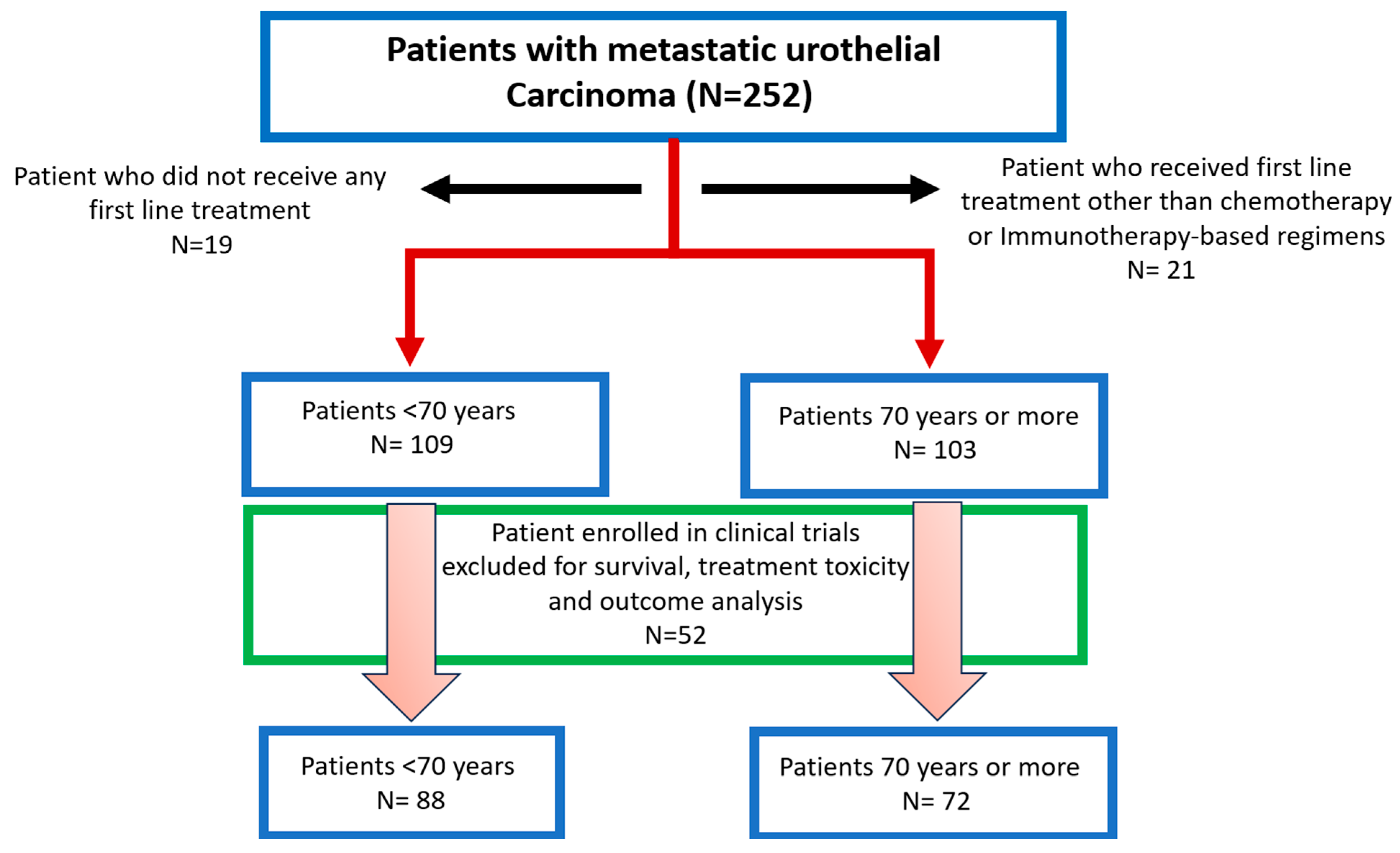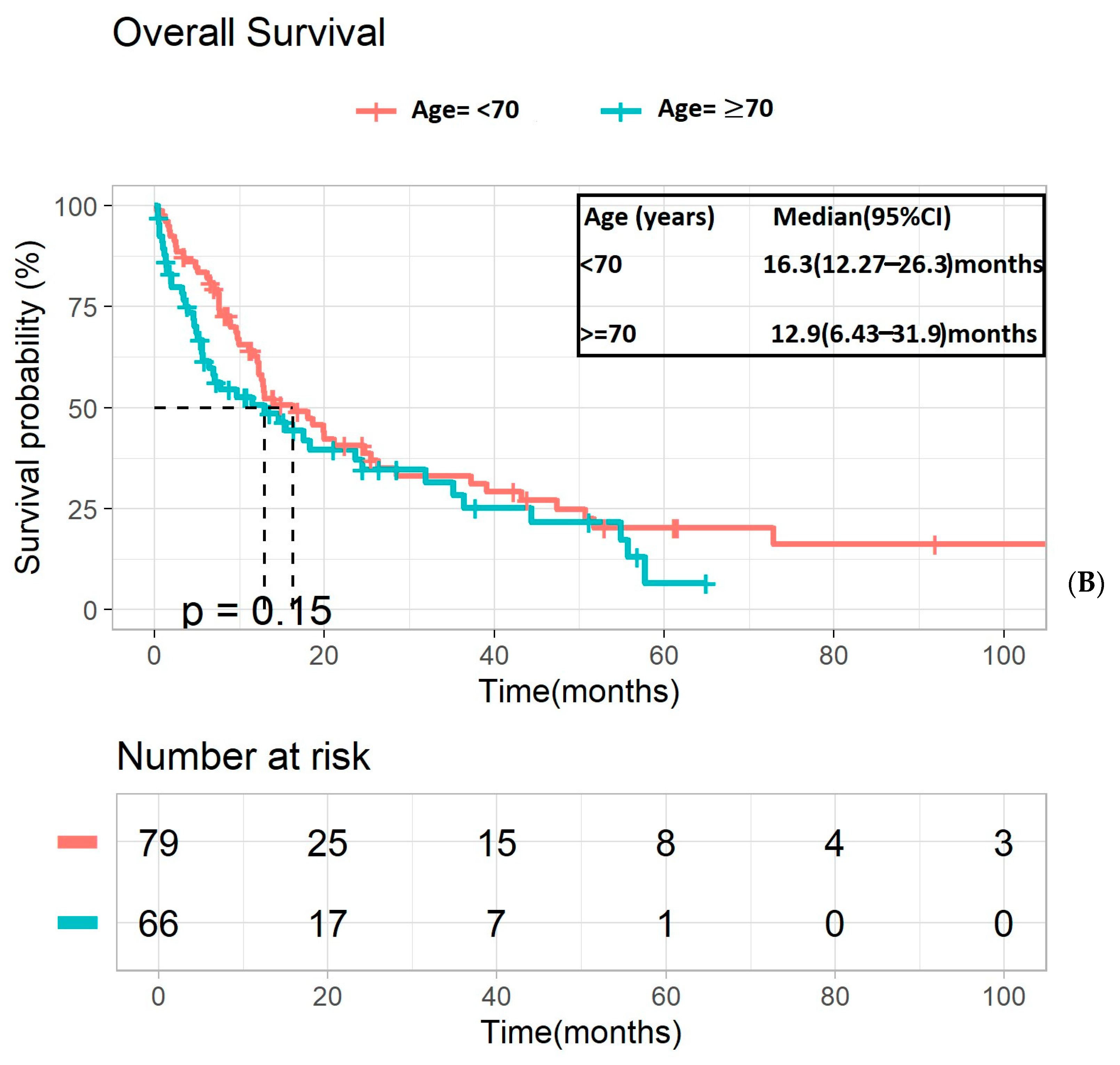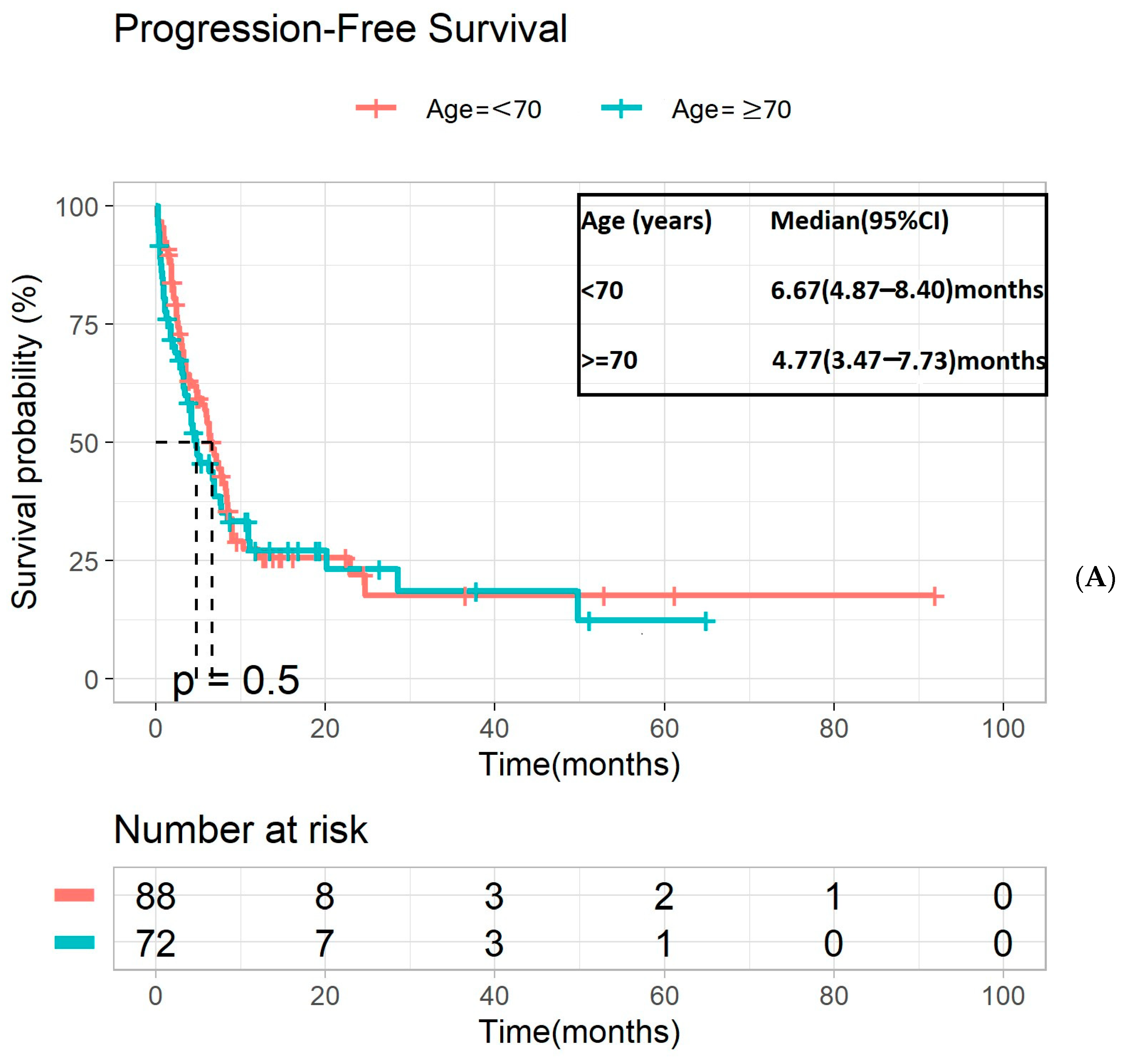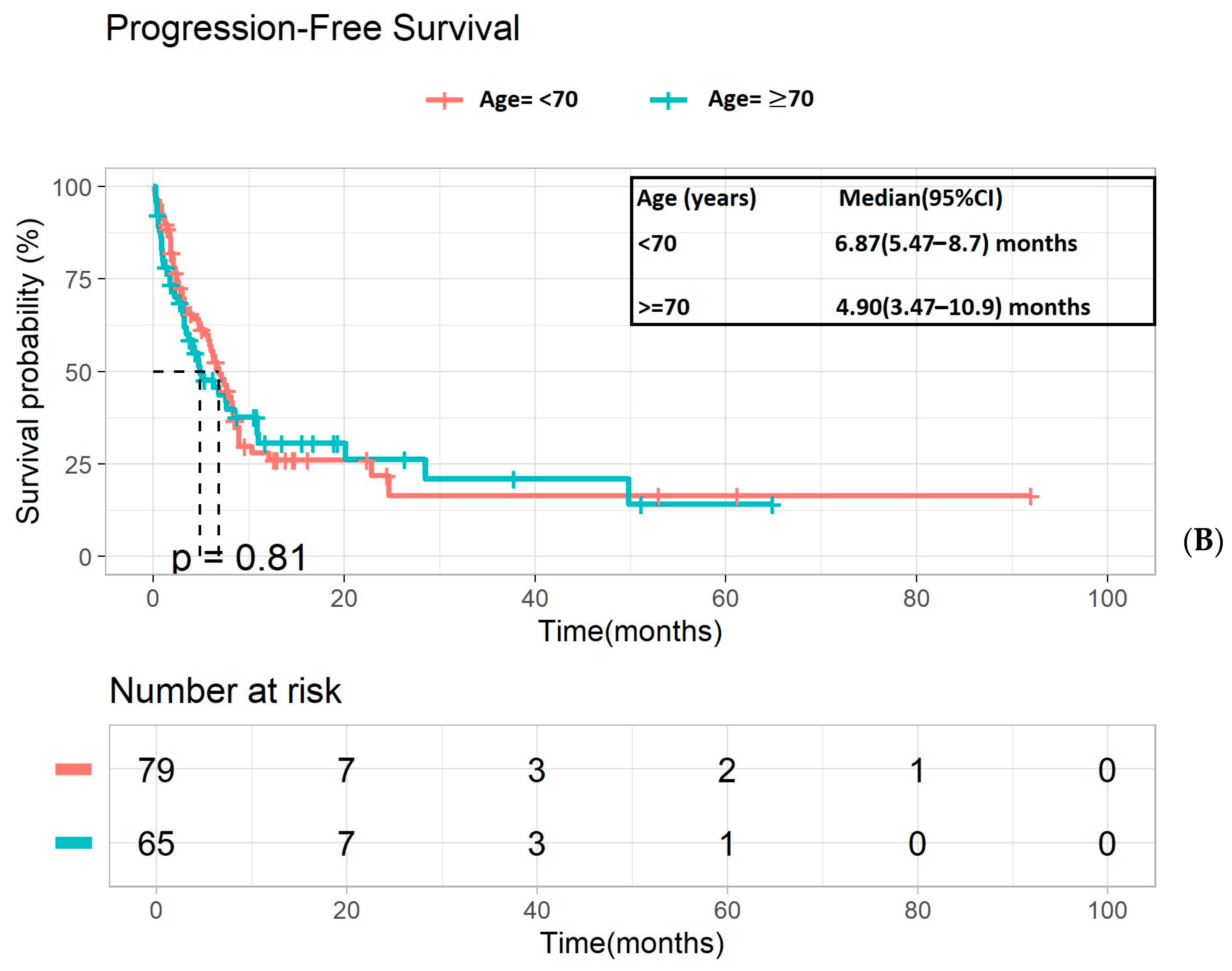Treatment Patterns and Outcomes by Age in Metastatic Urinary Tract Cancer: A Retrospective Tertiary Cancer Center Analysis
Abstract
Simple Summary
Abstract
1. Introduction
2. Methods
2.1. Patient Selection
2.2. Outcomes
2.3. Statistical Analysis
3. Results
3.1. Baseline Characteristics
3.2. Survival Outcomes
3.3. Treatment-Related Outcomes
3.4. Treatment-Associated Healthcare Visits
3.5. Discharge Disposition
3.6. Patients Aged 85 Years and Above
4. Discussion
5. Conclusions
Supplementary Materials
Author Contributions
Funding
Institutional Review Board Statement
Informed Consent Statement
Data Availability Statement
Acknowledgments
Conflicts of Interest
References
- NCCN Clinical Practice Guidelines in Oncology (NCCN Guidelines®) Bladder Cancer Version 4.2023. Available online: https://www.nccn.org/professionals/physician_gls/pdf/bladder.pdf (accessed on 5 September 2023).
- Galsky, M.D.; Hahn, N.M.; Rosenberg, J.E.; Sonpavde, G.; Hutson, T.E.; Oh, W.; Dreicer, R.; Vogelzang, N.J.; Sternberg, C.N.; Bajorin, D.F.; et al. A Consensus Definition of Patients with Metastatic Urothelial Carcinoma Who Are Unfit for Cisplatin-Based Chemotherapy. Lancet Oncol. 2011, 12, 211–214. [Google Scholar] [CrossRef] [PubMed]
- Balar, A.V.; Galsky, M.D.; Rosenberg, J.E.; Powles, T.; Petrylak, D.P.; Bellmunt, J.; Loriot, Y.; Necchi, A.; Hoffman-Censits, J.; Perez-Gracia, J.L.; et al. Atezolizumab as first-line treatment in cisplatin-ineligible patients with locally advanced and metastatic urothelial carcinoma: A single-arm, multicentre, phase 2 trial. Lancet 2017, 389, 67–76. [Google Scholar] [CrossRef] [PubMed]
- Balar, A.V.; Castellano, D.; O’Donnell, P.H.; Grivas, P.; Vuky, J.; Powles, T.; Plimack, E.R.; Hahn, N.M.; de Wit, R.; Pang, L.; et al. First-line pembrolizumab in cisplatin-ineligible patients with locally advanced and unresectable or metastatic urothelial cancer (KEYNOTE-052): A multicentre, single-arm, phase 2 study. Lancet 2017, 18, 1483–1492. [Google Scholar] [CrossRef] [PubMed]
- O’Donnell, P.H.; Milowsky, M.I.; Petrylak, D.P.; Hoimes, C.J.; Flaig, T.W.; Mar, N.; Moon, H.H.; Friedlander, T.W.; McKay, R.R.; Bilen, M.A.; et al. Enfortumab Vedotin with or without Pembrolizumab in Cisplatin-Ineligible Patients with Previously Untreated Locally Advanced or Metastatic Urothelial Cancer. J. Clin. Oncol. 2023, 41, 4107–4117. [Google Scholar] [CrossRef] [PubMed]
- Mori, K.; Mostafaei, H.; Abufaraj, M.; Yang, L.; Egawa, S.; Shariat, S.F. Smoking and bladder cancer: Review of the recent literature. Curr. Opin. Urol. 2020, 30, 720–725. [Google Scholar] [CrossRef] [PubMed]
- Yu, J.; Lee, J.; Ha, S.; Baek, J.W.; Kim, C.S.; Park, J.Y.; Kim, Y.K. Impact of Chart-Derived Frailty Index on 1-Year Mortality After Radical Cystectomy in 1004 Patients with Bladder Cancer. Ann. Surg. Oncol. 2023, 30, 5295–5303. [Google Scholar] [CrossRef] [PubMed]
- Pyrgidis, N.; Sokolakis, I.; Haltmair, G.; Hatzichristodoulou, G. The Short- and Long-Term Effect of Radical Cystectomy in Frail Patients With Bladder Cancer. Clin. Genitourin. Cancer 2023, 21, e291–e298. [Google Scholar] [CrossRef] [PubMed]
- Fonteyne, V.; Ost, P.; Bellmunt, J.; Droz, J.P.; Mongiat-Artus, P.; Inman, B.A.; Paillaud, E.; Saad, F.; Ploussard, G. Curative Treatment for Muscle Invasive Bladder Cancer in Elderly Patients: A Systematic Review. Eur. Urol. 2018, 73, 40–50. [Google Scholar] [CrossRef] [PubMed]
- Hurria, A.; Togawa, K.; Mohile, S.G.; Owusu, C.; Klepin, H.D.; Gross, C.P.; Lichtman, S.M.; Gajra, A.; Bhatia, S.; Katheria, V.; et al. Predicting chemotherapy toxicity in older adults with cancer: A prospective multicenter study. J. Clin. Oncol. 2011, 29, 3457–3465. [Google Scholar] [CrossRef]
- Swaminathan, D.; Swaminathan, V. Geriatric oncology: Problems with under-treatment within this population. Cancer Biol. Med. 2015, 12, 275–283. [Google Scholar] [CrossRef][Green Version]
- Soto-Perez-de-Celis, E.; Li, D.; Yuan, Y.; Lau, Y.M.; Hurria, A. Functional versus chronological age: Geriatric assessments to guide decision making in older patients with cancer. Lancet Oncol. 2018, 19, e305–e316. [Google Scholar] [CrossRef] [PubMed]
- Dell’Oglio, P.; Tappero, S.; Panunzio, A.; Antonelli, A.; Salvador, D.; Xylinas, E.; Alvarez-Maestro, M.; Hurle, R.; Salas, R.S.; Colomer, A.; et al. European Association of Urology-Young Academic Urologists (EAU-YAU): Urothelial Carcinoma Working Group. Age represents the main driver of surgical decision making in patients candidate to radical cystectomy. J. Surg. Oncol. 2023, 128, 142–154. [Google Scholar] [CrossRef] [PubMed]
- Talarico, L.; Chen, G.; Pazdur, R. Enrollment of elderly patients in clinical trials for cancer drug registration: A 7-year experience by the US Food and Drug Administration. J. Clin. Oncol. 2004, 22, 4626–4631. [Google Scholar] [CrossRef] [PubMed]
- Hurria, A.; Dale, W.; Mooney, M.; Rowland, J.H.; Ballman, K.V.; Cohen, H.J.; Muss, H.B.; Schilsky, R.L.; Ferrell, B.; Extermann, M.; et al. Cancer and Aging Research Group. Designing therapeutic clinical trials for older and frail adults with cancer: U13 conference recommendations. J. Clin. Oncol. 2014, 32, 2587–2594. [Google Scholar] [CrossRef] [PubMed]
- Hutchins, L.F.; Unger, J.M.; Crowley, J.J.; Coltman, C.A.J.; Albain, K.S. Underrepresentation of patients 65 years of age or older in cancer-treatment trials. N. Engl. J. Med. 1999, 341, 2061–2067. [Google Scholar] [CrossRef] [PubMed]
- BrintzenhofeSzoc, K.; Krok-Schoen, J.L.; Canin, B.; Parker, I.; MacKenzie, A.R.; Koll, T.; Vankina, R.; Hsu, C.D.; Jang, B.; Pan, K.; et al. The underreporting of phase III chemo-therapeutic clinical trial data of older patients with cancer: A systematic review. J. Geriatr. Oncol. 2020, 11, 369–379. [Google Scholar] [CrossRef] [PubMed]
- Shenoy, P.; Harugeri, A. Elderly patients’ participation in clinical trials. Perspect. Clin. Res. 2015, 6, 184–189. [Google Scholar] [CrossRef]
- Varma, T.; Mello, M.; Ross, J.S.; Gross, C.; Miller, J. Metrics, baseline scores, and a tool to improve sponsor performance on clinical trial diversity: Retrospective cross sectional study. BMJ Med. 2023, 2, e000395. [Google Scholar] [CrossRef] [PubMed]
- Bin Riaz, I.; Islam, M.; Ikram, W.; Naqvi, A.; Maqsood, H.; Saleem, Y.; Riaz, A.; Ravi, P.; Wang, Z.; Hussain, S.A.; et al. Disparities in the Inclusion of Racial and Ethnic Minority Groups and Older Adults in Prostate Cancer Clinical Trials: A Meta-analysis. JAMA Oncol. 2023, 9, 180–187. [Google Scholar] [CrossRef]
- Dahm, P.; Gschwend, J.E. Malignant non-urothelial neoplasms of the urinary bladder: A review. Eur. Urol. 2003, 44, 672–681. [Google Scholar] [CrossRef]
- Galsky, M.D.; Pal, S.K.; Lin, S.W.; Ogale, S.; Zivkovic, M.; Simpson, J.; Derleth, C.; Schiff, C.; Sonpavde, G. Real-World Effectiveness of Chemotherapy in Elderly Patients with Metastatic Bladder Cancer in the United States. Bladder Cancer 2018, 4, 227–238. [Google Scholar] [CrossRef]
- Sonpavde, G.; Watson, D.; Tourtellott, M.; Cowey, C.L.; Hellerstedt, B.; Hutson, T.E.; Zhan, F.; Vogelzang, N.J. Administration of cisplatin-based chemotherapy for advanced urothelial carcinoma in the community. Clin. Genitourin. Cancer 2012, 10, 1–5. [Google Scholar] [CrossRef] [PubMed]
- Galsky, M.D.; Krege, S.; Lin, C.C.; Hahn, N.; Ecke, T.H.; Moshier, E.; Sonpavde, G.; Godbold, J.; Oh, W.K.; Bamias, A. Cisplatin-based combination chemotherapy in septuagenarians with metastatic urothelial cancer. Urol. Oncol. 2014, 32, 30.e15–30.e21. [Google Scholar] [CrossRef]
- Morgans, A.K.; Rahma, O.E.; Mhatre, S.K.; Ching-Yi, C.; Davies, J.; Martinalbo, J.; Davarpanah, N.N.; Pachynski, R. Treatment (tx) characteristics of patients (pts) with locally advanced or metastatic urothelial cancer (mUC) receiving checkpoint inhibitor (CPI) monotherapy in a US clinical practice. J. Clin. Oncol. 2019, 37 (Suppl. 15), 4526. [Google Scholar] [CrossRef]
- Powles, T.; Park, S.H.; Voog, E.; Caserta, C.; Valderrama, B.P.; Gurney, H.; Kalofonos, H.; Radulović, S.; Demey, W.; Ullén, A.; et al. Avelumab Maintenance Therapy for Advanced or Metastatic Urothelial Carcinoma. N. Engl. J. Med. 2020, 383, 1218–1230. [Google Scholar] [CrossRef]
- Jodon, G.; Fischer, S.M.; Kessler, E.R. Treatment of Urothelial Cancer in Elderly Patients: Focus on Immune Checkpoint Inhibitors. Drugs Aging 2018, 35, 409–421. [Google Scholar] [CrossRef]
- Russell, B.M.; Boussi, L.; Bellmunt, J. Management of Advanced Urothelial Carcinoma in Older and Frail Patients: Have Novel Treatment Approaches Improved Their Care? Drugs Aging 2022, 39, 271–284. [Google Scholar] [CrossRef] [PubMed]
- Psutka, S.P.; Gore, J.L.; Holt, S.K.; Dwyer, E.; Schade, G.; Grivas, P.; Hsieh, A.C.; Lee, J.K.; Montgomery, R.B.; Schweizer, M.T.; et al. Prospective evaluation of a comprehensive geriatric assessment (CGA) in multidisciplinary bladder cancer care: Feasibility and impact on decisional conflict. J. Clin. Oncol. 2022, 40 (Suppl. 6), 479. [Google Scholar] [CrossRef]
- Zangl, Q.; Wirth, J.; Karl, A.; Stief, C.; Zwissler, B.; Von Dossow, V. Value of Geriatric Assessment in Patients with Genitourinary Carcinoma. Oncology 2021, 35, 620–627. [Google Scholar] [CrossRef]
- Extermann, M.; Boler, I.; Reich, R.R.; Lyman, G.H.; Brown, R.H.; DeFelice, J.; Levine, R.M.; Lubiner, E.T.; Reyes, P.; Schreiber, F.J.; et al. Predicting the risk of chemotherapy toxicity in older patients: The Chemotherapy Risk Assessment Scale for High-Age Patients (CRASH) score. Cancer. 2012, 118, 3377–3386. [Google Scholar] [CrossRef]
- Li, D.; Sun, C.L.; Kim, H.; Soto-Perez-de-Celis, E.; Chung, V.; Koczywas, M.; Fakih, M.; Chao, J.; Cabrera Chien, L.; Charles, K.; et al. Geriatric Assessment–Driven Intervention (GAIN) on Chemotherapy-Related Toxic Effects in Older Adults with Cancer: A Randomized Clinical Trial. JAMA Oncol. 2021, 7, e214158. [Google Scholar] [CrossRef] [PubMed]
- Mohile, S.G.; Mohamed, M.R.; Xu, H.; Culakova, E.; Loh, K.P.; Magnuson, A.; Flannery, M.A.; Obrecht, S.; Gilmore, N.; Ramsdale, E.; et al. Evaluation of geriatric assessment and management on the toxic effects of cancer treatment (GAP70+): A cluster-randomised study. Lancet 2021, 398, 1894–1904. [Google Scholar] [CrossRef] [PubMed]





| Variables | <70 Years (n = 109) | ≥70 Years (n = 103) | p Value |
|---|---|---|---|
| Clinical Characteristics | |||
| 1L Treatment Received n (%) | 0.01 | ||
| Chemotherapy | 70/109 (64%) | 49/103 (48%) | |
| Immunotherapy | 39/109 (36%) | 54/103 (52%) | |
| Gender; n (%) | 0.09 | ||
| Male | 82/109 (75%) | 87/103 (84%) | |
| Female | 27/109 (25%) | 16/103 (16%) | |
| Race; n (%) | 0.11 | ||
| White | 101/109 (93%) | 98/103 (95%) | |
| Non-white | 8/109 (7%) | 5/103 (5%) | |
| Smoking Status; n (%) | <0.0001 | ||
| Yes | 61/107 (57%) | 48/102 (47%) | |
| No | 46/107 (43%) | 54/102 (53%) | |
| Tumor Location; n (%) | 0.93 | ||
| Lower tract | 81/109 (74%) | 75/103 (73%) | |
| Upper tract | 28/109 (26%) | 28/103 (27%) | |
| De novo metastatic disease at diagnosis; n (%) | 0.39 | ||
| Yes | 41/109 (38%) | 32/103 (31%) | |
| No | 68/109 (62%) | 71/103 (69%) | |
| Tumor Stage; n (%) | 0.24 | ||
| Stage less than II | 23/98 (24%) | 16/96 (17%) | |
| Stage II or more | 75/98 (76%) | 80/96 (83%) | |
| Tumor Histology; n (%) | 0.99 | ||
| Urothelial carcinoma | 98/109 (90%) | 97/103 (94%) | |
| Squamous cell carcinoma | 2/109 (2%) | 1/103 (1%) | |
| Neuroendocrine carcinoma | 5/109 (5%) | 5/103 (5%) | |
| Adenocarcinoma | 4/109 (3%) | 0 | |
| Prior definitive treatment of primary with surgery, RT, CRT * | 62/109 (57%) | 62/103 (60%) | 0.73 |
| Prior definitive surgery ** | 59/109 (54%) | 52/103 (50%) | 0.69 |
| Prior definitive RT or CRT (n = 27) *** | 12/109 (11%) | 12/103 (15%) | 0.57 |
| Prior Chemotherapy (neoadjuvant/adjuvant intent) | 0.57 | ||
| Yes | 40/109 (37%) | 33/103 (32%) | |
| No | 69/109 (63%) | 70/103 (68%) | |
| Lab Characteristics | |||
| ECOG at 1L Rx start | 0.75 | ||
| ECOG (0–1) | 75/89 (84%) | 79/97 (81%) | |
| ECOG (2–4) | 14/89 (16%) | 18/97 (19%) | |
| eGFR at 1L Rx start | 0.07 | ||
| <60 mL/min | 40/90 (44%) | 56/97 (58%) | |
| ≥60 mL/min | 50/90 (56%) | 41/97 (42%) | |
| Albumin at 1L Rx start | 0.38 | ||
| <3.5 mg/dL | 17/95 (18%) | 23/100 (23%) | |
| ≥3.5 mg/dL | 78/95 (82%) | 77/100 (77%) | |
| Hemoglobin at 1L Rx start **** | 0.03 | ||
| Below normal | 70/98 (71%) | 85/101 (84%) | |
| Normal or above | 28/98 (29%) | 16/101 (12%) | |
| Absolute lymphocyte count; median (range) | 1.25 (0.32–6.1) | 1.2 (0.27–9.1) | 0.79 |
| Absolute neutrophil count; median (range) | 4.86 (2.19–17.07) | 5.19 (1.96–16.63) | 0.88 |
| Platelet at 1L Rx start | 0.16 | ||
| <159 × 109/L | 6//98 (6%) | 12/101 (12%) | |
| 439 × 109/L | 92/98 (94%) | 89/101 (88%) | |
| Clinical Trial Participation | 0.05 | ||
| Yes | 20/109 (18%) | 31/103 (30%) | |
| No | 89/109 (82%) | 72/103 (70%) | |
| Any hearing impairment | <0.002 | ||
| Yes | 19/109 (17%) | 37/103 (36%) | |
| No | 90/109 (83%) | 66/103 (64%) | |
| Any grade neuropathy | 0.4 | ||
| Yes | 17/109 (16%) | 12/103 (12%) | |
| No | 92/109 (84%) | 91/103 (88%) | |
| Heart failure | 0.7 | ||
| Yes | 7/109 (6%) | 8/103 (8%) | |
| No | 102/109 (94%) | 95/103 (92%) | |
| Cisplatin eligibility | <0.001 | ||
| Yes | 48/88 (55%) | 19/72 (26%) | |
| No | 40/88 (45%) | 53/72 (74%) | |
| Subsequent lines of therapy received; median (range) | 1 (0–5) | 0 (0–3) | 0.003 |
| Number of cycles of chemotherapy (n = 108) *****; | 0.01 | ||
| median (range) | 5 (1–12) | 4 (0–6) | |
| Number of cycles of immunotherapy received; median (range) | 3 (1–35) | 5 (1–22) | 0.55 |
| Death events | 58/109 (53%) | 50/103 (49%) | 0.59 |
| Baseline Variables at Start of 1L Systemic Therapy | OS Hazard Ratio (95% Confidence Interval, p Value) |
|---|---|
| Age at diagnosis of mUTC (≥70) | 1.28 (0.84–1.94, 0.25) |
| Sex (male) | 0.80 (0.48–1.32, 0.38) |
| Tumor location (upper tract) | 1.65 (1.04–2.64, 0.03) |
| Smoking status (yes) | 0.80 (0.54–1.20, 0.28) |
| Presence of visceral metastases | 2.12 (1.40–3.22, 0.0004) |
| Presence of De novo disease at diagnosis (yes) | 1.26 (0.73–2.18, 0.41) |
| Receipt of prior definitive surgery or radiation | 0.59 (0.34–1.10, 0.05) |
| Cisplatin eligibility (yes) | 0.63 (0.41–0.97, 0.03) |
| ECOG of 2 or higher | 2.47 (1.46–4.19, 0.0008) |
| Albumin (normal ≥ 3.5 mg/dL) | 0.80 (0.52–1.22, 0.29) |
| <70 Years | ≥70 Years | p Value | |
|---|---|---|---|
| Chemotherapy (n = 108); n (%) | 25/65 (38.4) | 19/43 (44.1) | 0.55 |
| Immunotherapy (n = 52); n (%) | 6/23 (26.0) | 7/29 (24.1) | 0.88 |
| <70 Years | ≥70 Years | p Value | |
|---|---|---|---|
| Chemotherapy (n = 108); median (range) | |||
| ED visits | 0 (0–8) | 0 (0–3) | 0.94 |
| Hospitalization | 0 (0–4) | 0 (0–3) | 0.36 |
| Immunotherapy (n = 52); median (range) | |||
| ED visits | 0 (0–7) | 0 (0–2) | 0.54 |
| Hospitalization | 0 (0–4) | 0 (0–2) | 0.90 |
| <70 Years (n = 45) | ≥70 Years (n = 35) | p Value | |
|---|---|---|---|
| Home with self-care; n (%) | 35/45 (77.7) | 29/35 (82.8) | 0.57 |
| Home with home health care; n (%) | 18/45 (40.0) | 8/35 (22.8) | 0.10 |
| Home Hospice; n (%) | 5/45 (11.1) | 7/35 (20.0) | 0.27 |
| Skilled Nursing home; n (%) | 4/45 (8.8) | 5/35 (14.2) | 0.45 |
| Death; n (%) | 3/45 (6.6) | 1/35 (2.8) | 0.43 |
Disclaimer/Publisher’s Note: The statements, opinions and data contained in all publications are solely those of the individual author(s) and contributor(s) and not of MDPI and/or the editor(s). MDPI and/or the editor(s) disclaim responsibility for any injury to people or property resulting from any ideas, methods, instructions or products referred to in the content. |
© 2024 by the authors. Licensee MDPI, Basel, Switzerland. This article is an open access article distributed under the terms and conditions of the Creative Commons Attribution (CC BY) license (https://creativecommons.org/licenses/by/4.0/).
Share and Cite
Tripathi, N.; Gebrael, G.; Chigarira, B.; Sahu, K.K.; Balasubramanian, I.; Caparas, C.; Mathew Thomas, V.; Cohan, J.N.; Pelletier, K.; Maughan, B.L.; et al. Treatment Patterns and Outcomes by Age in Metastatic Urinary Tract Cancer: A Retrospective Tertiary Cancer Center Analysis. Cancers 2024, 16, 2143. https://doi.org/10.3390/cancers16112143
Tripathi N, Gebrael G, Chigarira B, Sahu KK, Balasubramanian I, Caparas C, Mathew Thomas V, Cohan JN, Pelletier K, Maughan BL, et al. Treatment Patterns and Outcomes by Age in Metastatic Urinary Tract Cancer: A Retrospective Tertiary Cancer Center Analysis. Cancers. 2024; 16(11):2143. https://doi.org/10.3390/cancers16112143
Chicago/Turabian StyleTripathi, Nishita, Georges Gebrael, Beverly Chigarira, Kamal Kant Sahu, Ishwarya Balasubramanian, Constance Caparas, Vinay Mathew Thomas, Jessica N. Cohan, Kaitlyn Pelletier, Benjamin L. Maughan, and et al. 2024. "Treatment Patterns and Outcomes by Age in Metastatic Urinary Tract Cancer: A Retrospective Tertiary Cancer Center Analysis" Cancers 16, no. 11: 2143. https://doi.org/10.3390/cancers16112143
APA StyleTripathi, N., Gebrael, G., Chigarira, B., Sahu, K. K., Balasubramanian, I., Caparas, C., Mathew Thomas, V., Cohan, J. N., Pelletier, K., Maughan, B. L., Agarwal, N., Swami, U., & Gupta, S. (2024). Treatment Patterns and Outcomes by Age in Metastatic Urinary Tract Cancer: A Retrospective Tertiary Cancer Center Analysis. Cancers, 16(11), 2143. https://doi.org/10.3390/cancers16112143






